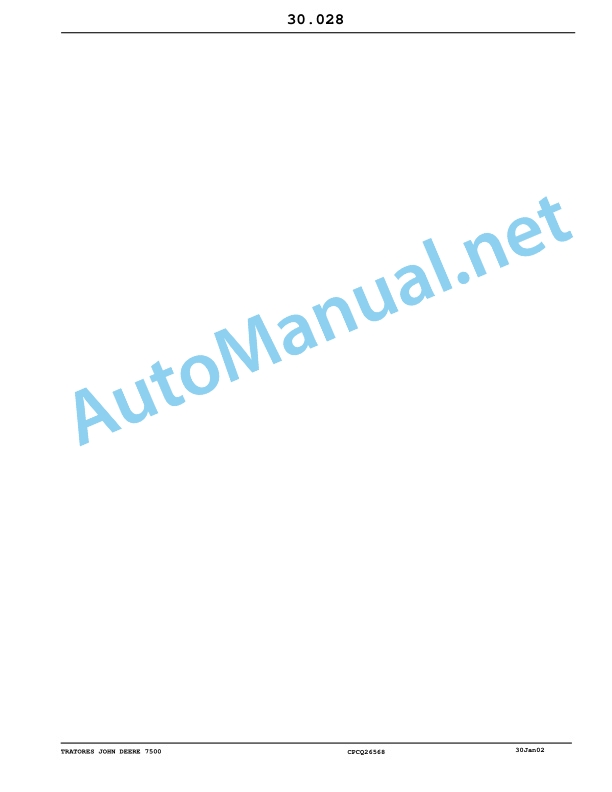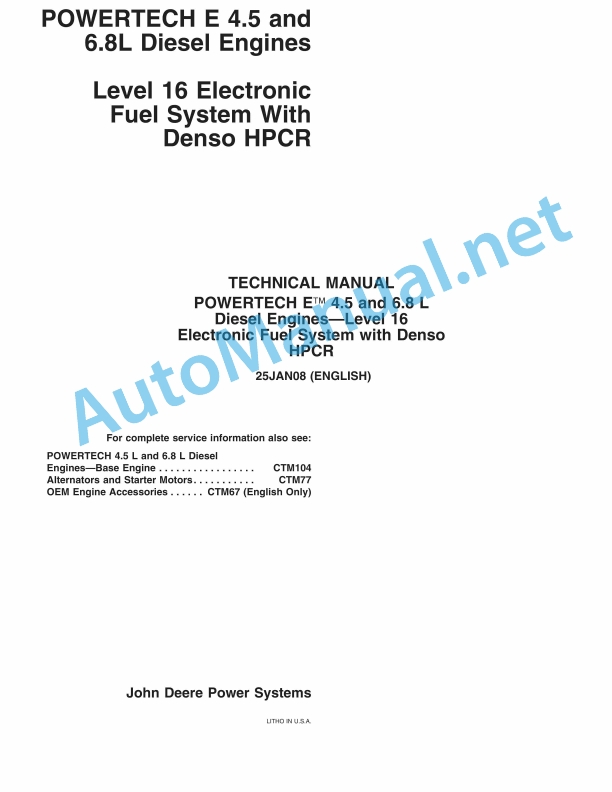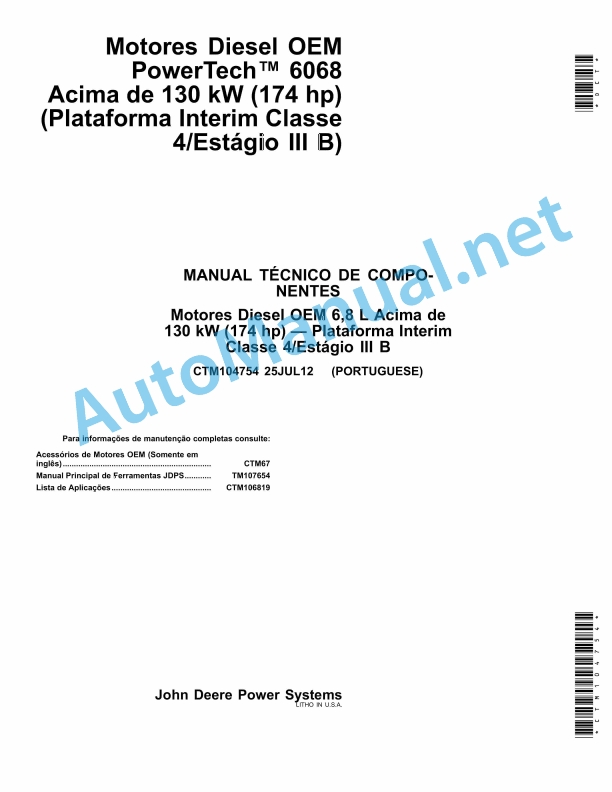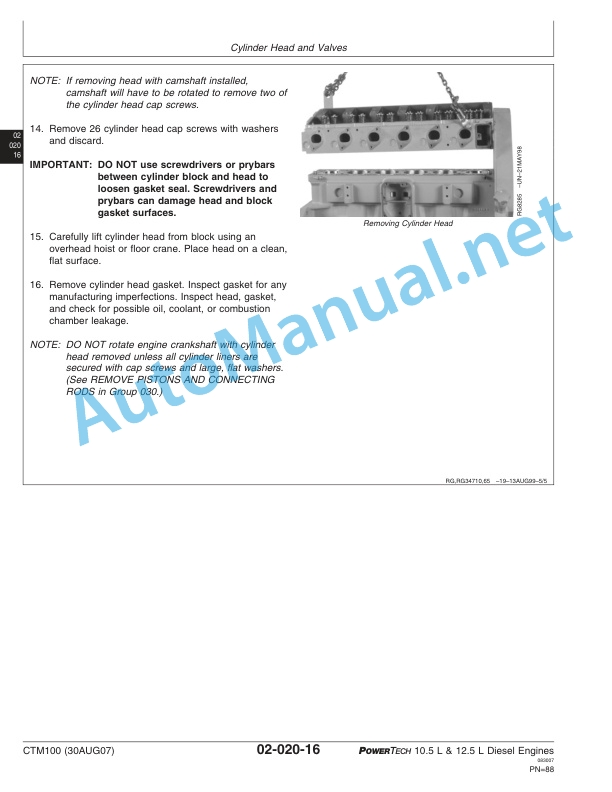Claas Nexos Vl 240-210 (A26) Tractors Operator Manual ES
$50.00
- Model: Nexos Vl 240-210 (A26) Tractors
- Type Of Manual: Operator Manual
- Language: ES
- Format: PDF(s)
- Size: 20.9 MB
File List:
00 2186 732 0.pdf
00 2186 732 0.pdf:
NEXOS VE 230-220-210
NEXOS VL 240-230-220-210
NEXOS F 240-230-220-210
1 Regarding this instruction manual
1.1 Information regarding the instruction manual
1.1.1 Use the user manual
Important information about this user manual
Structuring according to tractor subassemblies
Search and find
Direction signs
Specific terminology
Optional equipment and supplementary equipment
1.1.2 Symbols and instructions
Texts and illustrations
Indication of dangers and warnings
1.1.3 Validity of the user manual
1.1.4 Technical instructions
2 Security
2.1 Safety instructions
2.1.1 Use according to assignment
2.1.2 Use not in accordance with assignment
2.1.3 European regulations
2.1.4 Safety and accident prevention instructions
2.1.5 Driving the tractor
2.1.6 Checking the condition of the tractor
2.1.7 Getting on/off the tractor
Climb aboard the tractor
tractor lowering
2.1.8 Cabin
Cabin safety structure
Polluted environment
2.1.9 Necessary precautions before start-up
2.1.10 Tool attachment
2.1.11 Adjustment and maintenance operations
Particularities of placing the tractor on lifting supports
2.1.12 Using the front/rear power take-off
2.1.13 Fuel
2.1.14 Engine coolant
2.1.15 Air conditioning
2.1.16 Electrical system
2.1.17 Applications with front loaders
2.1.18 Forestry applications
2.1.19 Work in fixed position
2.2 Safety marking on the tractor
2.2.1 General advice regarding safety markings
2.2.2 Warning symbols
2.3 Safety devices
2.3.1 Wheel chock
3 Description of the tractor
3.1 Overview
3.1.1 Left front view
3.1.2 Left rear view
3.2 Identification plates and vehicle identification number
3.2.1 Spare parts and technical issues
3.2.2 Tractor nameplate
Tractor identification number
3.2.3 Tractor power label
3.2.4 Motor nameplate
3.2.5 Transmission nameplate
3.2.6 Front axle nameplate
Four-wheel drive tractor
Two-wheel drive tractor
3.2.7 Cab nameplate
4 Control and display instruments
4.1 Cabin
4.1.1 Driving position
Right side controls
Left side controls
4.1.2 Dashboard
Tractors with low torque inverter
Tractors with mechanical inverter
4.1.3 Rear mechanical linkage controls
4.1.4 “TCE 6” electronic elevator controls
4.1.5 Instrument panel
4.1.6 Digital display
4.1.7 Key contactor
4.1.8 Heating, ventilation and air conditioning controls
4.1.9 Control lever for signal lights and acoustic warning
4.1.10 Work light controls
Cabin version
Platform version
4.1.11 Power outlet from an electrical box
4.2 Hydraulic installation
4.2.1 Hydraulic controls
Front hydraulic lift
Conversion of double-acting/single-acting auxiliary hydraulic distributors
4.3 Electrical/electronic installation
4.3xal controls
Rear mechanical lift
“TCE 6” electronic rear lift
4.4 Parts for assembly / machine body
4.4.1 Toolbox
5 Technical data
5.1 NEXUS
5.1.1 Dimensions
Cabin version
Platform version
5.1.2 Weight
Cabin version (with two-wheel drive)
Cab version (with four-wheel drive)
Platform version (with two-wheel drive)
Platform version (with four-wheel drive)
5.1.3 Engine
5.1.4 Gearbox
mechanical transmission
Electrohydraulic transmission
5.1.5 Travel speeds
5.1.6 Without duplicator and 12/12 gearbox – 30 km/h version
5.1.7 Mechanical duplicator and 24/24 gearbox – 40 km/h version
5.1.8 electrohydraulic duplicator
24/24 gearbox – 30 km/h version
Gearbox 24/12 – 40 km/h version
5.1.9 Front axle (two-wheel drive)
5.1.10 Engine front axle (four-wheel drive)
Synchronism ratio
5.1.11 Rear axle
5.1.12 Brakes
5.1.13 Address
5.1.14 Rear hydraulic lift
5.1.15 Front hydraulift
5.1.16 Rear hitches
5.1.17 Rear PTO
5.1.18 Front power take-off
5.1.19 Hydraulic circuits
Open central circuit 59 l/min
Open central circuit 85 l/min
5.1.20 Auxiliary hydraulic distributor combinations
Auxiliary hydraulic distributors
Auxiliary electrohydraulic distributors
5.1.21 Electrical circuit
5.1.22 Noise level
Noise level in the driver’s ears (according to European directive 2009/76)
Noise level in the ears of a passerby (according to European directive 2009/63 Annex VI)
5.1.23 Seat vibration level
5.1.24 Ballast
Compatibility of ballasts with tires
5.1.25 Maximum allowable towable masses
Two-wheel drive version
Four-wheel drive version
5.1.26 Load capacities
5.1.27 Lubricants/Hydraulic Oils
5.1.28 Engine coolant
5.1.29 Brake fluid
5.1.30 Air conditioning circuit
6 Prepare the tractor
6.1 Engine
6.1.1 Fuel
Quality requirement
Fuel handling
6.1.2 Filling the fuel tank
6.2 Framework
6.2.1 NEXOS 230-210 VE: Front track table
Front axle (Four-wheel drive version)
Front axle (two-wheel drive version)
6.2.2 NEXOS 230-210 VE: Rear track table
6.2.3 NEXOS 240-210 VL: Front track table
Front axle (Four-wheel drive version)
Front axle (two-wheel drive version)
6.2.4 NEXOS 240-210 VL: Rear track table
6.2.5 NEXOS 240-210 F: Front track table
Front axle (Four-wheel drive version)
Front axle (two-wheel drive version)
6.2.6 NEXOS 240-210 F: Rear track table
6.2.7 Tire combinations
6.2.8 Rear axle track adjustment
Track adjustment method
6.2.9 Adjustment of the rotation stops
Adjustment
6.2.10 General characteristics of the tires
6.2.11 Inflation pressure
Effect on soil compaction
Effect on consumption
6.2.12 Features
Load index
speed index
6.3 Brake
6.3.1 Brake pedal engagement
6.3.2 Hydraulic trailer brake
6.4 Address
6.4.1 Steering column
6.5 Rear linkage
6.5.1 Lifting supports
6.5.2 Upper connecting rod
6.5.3 Stabilizers
NEXUS VE – VL
6.5.4 Vertical tie rod of the hydraulic system
6.5.5 Automatic hooks
6.5.6 External controls
Mechanical lifting
Hydraulic lifting
6.5.7 Attaching/disengaging a tool
Hitch Recommendations
Disengagement
6.6 Front linkage
6.6.1 Conversion of the front hydraulic linkage into single-acting/double-acting
6.6.2 Front hydraulic linkage lock
6.6.3 Upper connecting rod
6.6.4 Lower cranks
6.6.5 Automatic hooks
6.6.6 Attaching/disengaging a tool
Hitch Recommendations
Disengagement
6.7 Rear PTO
6.7.1 Attaching/disengaging a tool
Connecting/disconnecting the rear PTO cardan
Disengagement
6.7.2 Attaching tools to the power take-off
6.8 Towing device
6.8.1 Recommendations
6.8.2 Calculation of maximum towable load (not including CUNA forks)
6.8.3 Hitch forks
6.8.4 Oscillating bar
Jaw tightening
Safety device
6.8.5 Pull hook
6.9 Rear hydraulic system
6.9.1 Rear pressure taps
Connection/Disconnection of pressure taps
Free return to deposit
6.9.2 Single acting/double acting adjustment
6.10 Electrical/electronic installation
6.10.1 Electrical sockets
Trailer/tool lighting socket
Power outlet for electrical box
6.10.2 Low beam adjustment
6.11 Driver’s cabin/platform
6.11.1 Mirror adjustment
6.11.2 Folding arch
6.11.3 Turn signals – Platform version
6.11.4 Comfort driver seat adjustment, cab version
6.11.5 Adjustment of the driver’s pneumatic seat – Cab version
6.11.6 Adjustment of the driver’s seat (waterproof seat) – Platform version tractors
6.11.7 Cable routing
6.11.8 Compartments
6.12 Attached parts, machine housing
6.12.1 Ballast
6.12.2 Balancing the tractor with mounted tools
Summary table
6.12.3 Assembly and disassembly he front hts
6.12.4 Opening and closing of covers
Monobloc cover
Side covers
6.13 Tractor transport
6.13.1 Transport
7 Management
7.1 Engine
7.1.1 Break-in
7.1.2 Engine starting
Preliminary operations
Start up
7.1.3 Accelerator pedal
7.1.4 Hand throttle
7.1.5 Engine stop
7.2 Gears / clutch / cardan shaft
7.2.1 Neutral position of the inverter
Tractors with mechanical inverter
Tractors with low torque inverter
7.2.2 Selection of tractor forward direction
recommendations
mechanical inverter
Inverter under par
7.2.3 Clutch
inch pedal
Contactor (Tractors with low torque inverter)
7.2.4 Speed selection
7.2.5 Range selection
7.2.6 Range duplicator
Mechanical range bender
Electrohydraulic range duplicator
7.2.7 Differential lock
7.3 Chassis
7.3.1 Front axle activation
General characteristics
Automatic mode
Permanent mode
7.4 Brake
7.4.1 See brakes
2 Handbrake (auxiliary and parking brake)
7.5 Mechanical rear hydraulic lift
7.5.1 Position control
7.5.2 Effort control
7.5.3 Mixed control
7.5.4 Floating hitch
7.5.5 Sensitivity adjustment
7.5.6 External controls
7.6 Electronic rear hydraulic lift
7.6.1 Safety pilot
7.6.2 Transport security
7.6.3 Lift start-up
7.6.4 Mode selection
7.6.5 Position control
7.6.6 Effort control
7.6.7 Upper stop
7.6.8 Descent speed
7.6.9 Quick ground function
7.6.10 External controls
7.7 Front linkage
7.7.1 Use
Mechanical Control Auxiliary Hydraulic Distributor
Electrohydraulic distributor
7.8 Rear PTO
7.8.1 PTO speed selection
Selection of power take-off regime proportional to the advance
7.8.2 Use
Assisted mechanical activation power take-off
PTO with electrohydraulic start
7.8.3 Work in fixed position
7.9 Front power take-off
7.9.1 Use
Activation of the front power take-off
7.10 Rear hydraulic system
7.10.1 Rear controls and pressure taps
Auxiliary hydraulic distributors with mechanical control
Electrohydraulic Auxiliary Hydraulic Distributors
7.10.2 Auxiliary hydraulic distributors with mechanical control
7.10.3 Auxiliary electrohydraulic distributors
Controls
Start up
Online controls
Cross control
7.10.4 Hydraulic timer
7.10.5 Adjustment of flow rates
Auxiliary hydraulic distributors with mechanical control
Auxiliary electrohydraulic distributors
7.10.6 Work in fixed position
7.11 Driver’s cabin/platform
7.11.1 Instrument panel display
7.11.2 Manual air conditioning control
7.11.3 Ceiling light
7.11.4 Windshield wiper and washer controls
Controls on the column
Cabin top controls
7.11.5 Access and glass
Openable windshield
Sunshade curtain
7.11.6 Viewer
8 Incident and solution
8.1 Alarms
8.1.1 Primary alarms
8.1.2 Secondary alarms
8.1.3 Other alarms
8.2 Engine
8.2.1 Failure due to lack of fuel
8.3 Framework
8.3.1 Jack placement
8.3.2 Changing a wheel
8.3.3 Tractor trailer
Trailer with engine running
Trailer with engine off
8.3.4 Unclogging the tractor
Tractor unclogging
Unclogging a tractor by towing
8.4 Electrical/electronic installation
8.4.1 Fuses and relays
Main fuse box
Right pillar fuse box
Left pillar fuses and relays
Fuse box under the instrument panel
Engine compartment fuse box
Fuses and relays of the auxiliary electrohydraulic distributors
8.4.2 Instrument panel parameterization
Procedure
Speed parameters table
8.4.3 Lights overview
9 Maintenance
9.1 Maintenance instructions
9.1.1 Personal protective equipment
9.1.2 Stopping and securing the tractor
9.1.3 Clean and organize risk areas
9.1.4 Welding instructions
9.1.5 Protection devices on the tractor
9.1.6 Engine
Alternator
ne lubrication
engine cooling
engine belts
9.1.7 Wheels and tires
9.1.8 Braking system
9.1.9 Address
9.1.10 Power take-off driven tools
9.1.11 Air conditioning
9.1.12 Hydraulic circuit
9.1.13 Electrical system
9.1.14 Energy accumulators
9.1.15 Spare parts
9.1.16 Greasing
9.1.17 Cleaning/protection
9.1.18 Work at height
9.1.19 Handling of heavy parts
9.1.20 Maintenance operations in the cabin
9.1.21 Lifting the front of the tractor
9.2 Summary of maintenance intervals
9.2.1 According to the national legislation in force in the country of circulation of the tractor
9.2.2 First 10 hours
9.2.3 First 40 hours
9.2.4 First 100 hours
9.2.5 In the first 500 hours or between the 8th and 10th month
9.2.6 Every 10 hours
9.2.7 Every 50 hours
9.2.8 Every 50 hours or every week
9.2.9 Every 100 hours
9.2.10 Every 250 hours
9.2.11 Every 400 hours
9.2.12 Every 500 hours
9.2.13 Every 500 hours or every six months
9.2.14 Every 500 hours or annually
9.2.15 Every 1000 hours
9.2.16 Every 1000 hours or every 2 years
9.2.17 Every 1500 hours
9.2.18 Every 1,500 hours or every two years
9.2.19 Every 1,800 hours
9.2.20 Every 2000 hours
9.2.21 Every 3000 hours
9.2.22 Every 4,500 hours
9.3 Greasing scheme
9.3.1 Grease points, 50 h
9.3.2 Grease points, 100 h
9.3.3 Grease points, 250 h
9.3.4 Grease points, 500 h
9.3.5 Grease points – 1000 h
9.4 Engine maintenance operations
9.4.1 Rocker arm control – NEXOS VE VL F (230 220 210)
9.4.2 Control of the rocker arms – NEXOS VL F (240)
9.4.3 Changing the fuel filter
Decanter pre-filter (depending on equipment)
Fuel filter
9.4.4 Checking the pipelines and injection circuit fittings
9.4.5 Changing the fuel strainer
9.4.6 Elimination of water present in fuel
Decanter pre-filter (depending on equipment)
Fuel filter
9.4.7 Cleaning the fuel strainer
9.4.8 Check the calibration pressure of the injectors
9.4.9 Injection pump control – NEXOS VL F (240)
9.4.10 Bleeding air from the injection circuit
NEXOS VE – VL – F (230 – 220 – 210)
NEXOS VL – F (240)
9.4.11 Engine oil change
NEXOS VE – VL – F (230 – 220 – 210)
NEXOS VL – F (240)
9.4.12 Changing the engine oil filter cartridge
9.4.13 Checking the engine oil level
9.4.14 Leakage check of the cooling liquid circuit
9.4.15 Coolant level control
9.4.16 Cleaning of refrigerators
9.4.17 Checking the alternator belt and engine water pump
NEXOS VE – VL – F (230 – 220 – 210)
NEXOS VL – F (240)
9.4.18 Changing the alternator belt and engine water pump
NEXOS VE – VL – F (230 – 220 – 210)
NEXOS VL – F (240)
9.4.19 Changing the engine cooling circuit fluid and thermostat
9.4.20 Tightening the collectors
9.4.21 Cleaning the exhaust duct
9.4.22 Turbocharger control – NEXOS VL F (240)
9.4.23 Cleaning the engine air filter
9.4.24 Changing the engine air filter
9.4.25 Air intake tightness check
9.4.26 Preheating control – NEXOS VL F (240)
9.4.27 Changing the engine ventilation filter safety cartridge
9.5 Gear maintenance operations
9.5.1 Control of the forward clutch distance (depending on equipment)
9.5.2 Control of the “Safety patch” solenoid valve (Tractor with low torque inverter)
9.6 Chassis maintenance work
9.6.1 Changing the front axle final reduction oil
9.6.2 Changing the oil in the front axle differential casing
9.6.3 Checking the tightness of the front axle
9.6.4 Control and adjustment of parallelism
9.6.5 Checking the oil level of the front axle final reductions
9.6.6 Changing the front axle vent
9.6.7 Checking the front axle differential casing oil level
9.6.8 Checking the tightening of the wheel discs on the hubs
9.6.9 Checking the tightening of the wheel discs on the rims
9.6.10 Tire inflation pressure check
9.7 Brake maintenance operns
9.7.1 Check anjustment of service brakes
9.7.2 Checking the service brake fluid level
9.7.3 Control of braking efficiency
9.7.4 Service brake distance control
9.7.5 Changing the brake circuit fluid
9.7.6 Changing the braking circuit reservoir cap
9.7.7 Handbrake clearance adjustment
9.8 Maintenance work at the address
9.8.1 Checking the correct operation of the hydrostatic steering
9.9 Hitch device maintenance operations
9.9.1 Checking fork play
9.10 Rear power take-off maintenance operations
9.10.1 PTO clutch distance control
9.10.2 Control of the clutch control of the assisted mechanical power take-off
9.11 Front power take-off maintenance operations
9.11.1 Checking the oil level of the front power take-off box
9.11.2 Changing the oil in the front power take-off box
9.12 Hydraulic installation maintenance work
9.12.1 Checking the hydraulic/transmission oil level
9.12.2 Third hydraulic pump belt control – NEXOS VL – F (240)
9.12.3 Inspection of hydraulic accumulators
9.12.4 Inspection of hydraulic accumulators (Tractor with low torque inverter)
9.12.5 Changing the third hydraulic pump belt – NEXOS VL F (240)
9.12.6 Changing the hydraulic/transmission circuit filter cartridge
9.12.7 Changing the hydraulic shower head
9.12.8 Hydraulic circuit control
9.12.9 Hydraulic/transmission oil change
9.13 Electrical/electronic installation maintenance work
9.13.1 Check the operation of the dry air filter obstruction warning light
9.13.2 Cleaning and greasing the battery terminals
9.13.3 Changing the engine air filter
9.13.4 Control of instrument panel operation
9.13.5 Control of lights and lighting indicators
9.14 Cabin/driving position maintenance operations
9.14.1 Checking the windshield washer fluid level
9.14.2 Control of proper functioning of ventilation, heating and air conditioning
9.14.3 Cleaning the cabin air filter
9.14.4 Air conditioning compressor lubrication
9.14.5 Changing the cabin air filter
9.14.6 Air conditioning compressor belt check
9.14.7 Control of the air conditioning dehydrator
9.14.8 Changing the air conditioning compressor belt
9.15 Bodywork maintenance operations
9.15.1 Checking the tightening of the connection screws
9.15.2 Cleaning the calender grates
9.16 Parking
9.16.1 Parking instructions
Long term parking
New tractor commissioning
10 Decommissioning and waste disposal
10.1 Information about the machine
10.1.1 Disposal and waste disposal
11 Technical dictionary and abbreviations
11.1 Technical dictionary and abbreviations
11.1.1 Technical terms
11.1.2 Abbreviations
John Deere Repair Technical Manual PDF
John Deere Parts Catalog PDF
John Deere Tractors 7500 Parts Catalog CPCQ26568 30 Jan 02 Portuguese
John Deere Repair Technical Manual PDF
John Deere POWERTECH E 4.5 and 6.8 L Diesel Engines TECHNICAL MANUAL 25JAN08
John Deere Repair Technical Manual PDF
John Deere Repair Technical Manual PDF
John Deere Repair Technical Manual PDF
John Deere Repair Technical Manual PDF
John Deere Repair Technical Manual PDF
John Deere Repair Technical Manual PDF




















